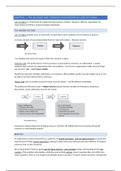Summary
Summary Book: Lean Six Sigma (for Service and Healthcare) - Operational Excellence course UVA
- Course
- Institution
- Book
Summary Lean Six Sigma for Service and Healthcare, ISBN: 7735 Operational Excellence (6314M0238Y) Every chapter of the book is summarized.
[Show more]




